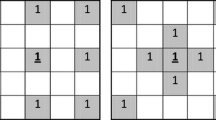Abstract
A comparative study of the performance of knee detection approaches for the hierarchical clustering of 2D spatial data is undertaken. Knee detection is usually performed on the dendogram generated during cluster generation. For many problems, the knee is a natural indication of the ideal or optimal number of clusters for the given problem. This research compares the performance of various knee strategies on different spatial datasets. Two hierarchical clustering algorithms, single linkage and group average, are considered. Besides determining knees using conventional cluster distances, we also explore alternative metrics such as average global medoid and centroid distances, and F score metrics. Results show that knee determination is difficult and problem dependent.
Access this chapter
Tax calculation will be finalised at checkout
Purchases are for personal use only
Similar content being viewed by others
References
Breaban, M., Iftene, A.: Dynamic objective sampling in many-objective optimization. Proc. Compt. Sci. 60, 178–187 (2015)
Franti, P.: Clustering Datasets (2015). http://cs.uef.fi/sipu/datasets/. Accessed 31 Oct 2017
Garey, M., Johnson, D.: Computers and Intractability. W.H. Freeman, New York (1979)
Hayter, A.: Probability and Statistics for Engineers and Scientists. Duxbury, Pacific Grove (2007)
Jr, D.K., Shook, C.: The application of cluster analysis in strategic management research: an analysis and critique. Strateg. Manag. J. 17, 441–458 (1996)
Online (2017). https://github.com/deric/clustering-benchmark. Accessed 31 Oct 2017
Ross, B.: A comparison of knee strategies for hierarchical spatial clustering. Technical report TR18-01, Brock U, Department of Computer Science, February 2018
Salvador, S., Chan, P.: Determining the number of clusters/segments in hierarchical clustering/segmentation algorithms. In: Proceedings of IEEE International Conference on Tools with Artificial Intelligence (ICTAI), pp. 576–584. IEEE (2004)
Suh, S.C.: Practical Applications of Data Mining. Jones & Bartlett Learning, Sudbury (2012)
Xie, J., Girshick, R., Farhadi, A.: Unsupervised deep embedding for cluster analysis. In: Proceedings of 33rd International Conference on Machine Learning. JMLR:W&CP (2008)
Zhang, Y., Zhang, X., Tang, J., Luo, B.: Decision-making strategies for multi-objective community detection in complex networks. In: Pan, L., Păun, G., Pérez-Jiménez, M.J., Song, T. (eds.) BIC-TA 2014. CCIS, vol. 472, pp. 621–628. Springer, Heidelberg (2014). https://doi.org/10.1007/978-3-662-45049-9_102
Acknowledgements
This research was supported by NSERC Discovery Grant RGPIN-2016-03653.
Author information
Authors and Affiliations
Corresponding author
Editor information
Editors and Affiliations
Rights and permissions
Copyright information
© 2018 Springer International Publishing AG, part of Springer Nature
About this paper
Cite this paper
Ross, B.J. (2018). A Comparison of Knee Strategies for Hierarchical Spatial Clustering. In: Mouhoub, M., Sadaoui, S., Ait Mohamed, O., Ali, M. (eds) Recent Trends and Future Technology in Applied Intelligence. IEA/AIE 2018. Lecture Notes in Computer Science(), vol 10868. Springer, Cham. https://doi.org/10.1007/978-3-319-92058-0_8
Download citation
DOI: https://doi.org/10.1007/978-3-319-92058-0_8
Published:
Publisher Name: Springer, Cham
Print ISBN: 978-3-319-92057-3
Online ISBN: 978-3-319-92058-0
eBook Packages: Computer ScienceComputer Science (R0)




